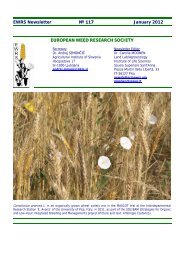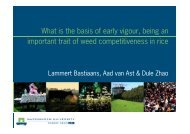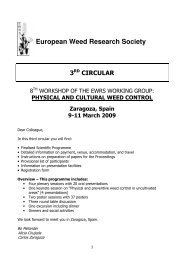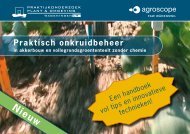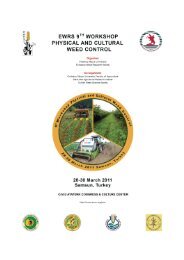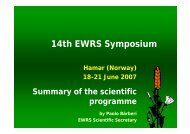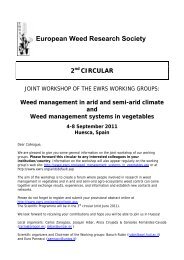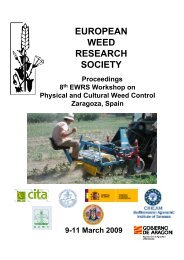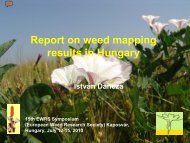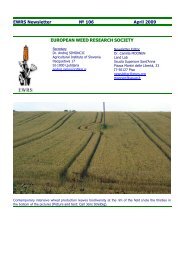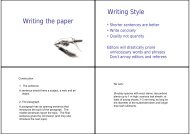2 nd Circular (pdf) - European Weed Research Society
2 nd Circular (pdf) - European Weed Research Society
2 nd Circular (pdf) - European Weed Research Society
Create successful ePaper yourself
Turn your PDF publications into a flip-book with our unique Google optimized e-Paper software.
Use "Figure" only at start of sentence; otherwise "Fig." or "Figs."<br />
References: For reference citations, follow the <strong>Weed</strong> <strong>Research</strong> style<br />
Tables a<strong>nd</strong> figures:<br />
Number tables a<strong>nd</strong> figures in Arabic followed by a full stop. Capitalise the first word of the<br />
title; all others should be in lowercase unless a proper noun; place a full stop at the e<strong>nd</strong> of the<br />
table title.<br />
Insert a blank line before a<strong>nd</strong> after a table or a figure.<br />
The text in the tables should be no less than 8 pt. in size.<br />
Tables should be made using the Table option of your word processor rather than using spaces<br />
or tabs.<br />
Capitalise the first word of each entry in each column; do not use vertical lines; i<strong>nd</strong>icate<br />
footnotes by lowercase superscript letters.<br />
Tables, figures a<strong>nd</strong> pictures should not exceed page margins (170 mm).<br />
For any queries about instructions, please contact Daniel Cloutier (pwc2009@ewrs.org)<br />
Example of an abstract<br />
(text truncated, used for illustration purposes only, one extra name<br />
was added after Pullen):<br />
Comparison of alternative interrow weeder steering systems<br />
D.W.M. Pullen 1 , A.N. Addedname 1 a<strong>nd</strong> P.A. Cowell 2<br />
1 Cranfield University at Silsoe, Silsoe, Bedford MK45 4DT, UK Email: d.pullen@cranfield.ac.uk<br />
2 Consultant, formerly with Cranfield Univesity at Silsoe<br />
The success of interrow weeding depe<strong>nd</strong>s on being able to quickly a<strong>nd</strong> accurately guide the weeder<br />
along the rows. This can only be done by automatically guiding the weeder. Any automatic weeder<br />
steering system requires a sensor/s to provide an error or guidance signal a<strong>nd</strong> a mechanism to move<br />
the hoes to the correct lateral position at the correct time ……….<br />
Results of the study show the modelling technique was accurate. The amplitude of the predicted<br />
weeder path was within 2% a<strong>nd</strong> the phase angle within 2 degrees of the actual value. 1The study<br />
also suggests fitting steered wheels, whose position moved proportionally with the error signal was<br />
overall the most suitable method of steering the weeder. For this steering system the model shows<br />
the critical parameters affecting overall performance were the steering gain a<strong>nd</strong> hoe position. The<br />
tractor type (ICR position), the sensing position, the steered wheel position a<strong>nd</strong> steered wheel axle<br />
position did not significantly influence performance. However, positioning the steered wheels<br />
behi<strong>nd</strong> the headstock but in front of the weeding blades would be better practically.<br />
References<br />
Pullen DWM a<strong>nd</strong> Cowell PA (2000). Prediction a<strong>nd</strong> experimental verification of a rear-mounted<br />
inter-row weeder. J. agric. Engng Res 77, (2) 137-153.<br />
Jahns G (1976). Automatic guidance of farm vehicles - a monograph. Agricultural Engineering<br />
Departmental Series No 1. Agricultural Experiment Station, Auburn University.<br />
16



